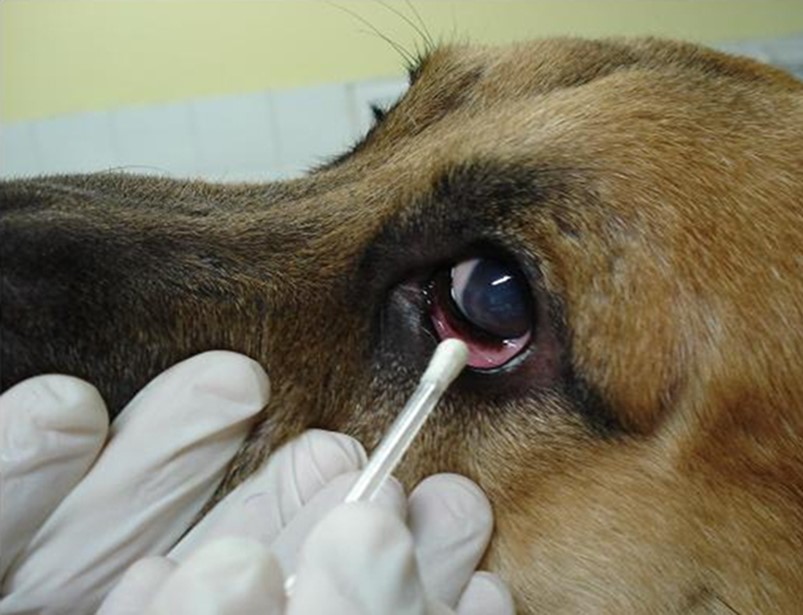Prueba inmunocromatográfica rápida en el diagnóstico del moquillo canino
Immunochromatographic rapid test in diagnosis of canine distemper


Esta obra está bajo una licencia internacional Creative Commons Atribución-NoComercial-CompartirIgual 4.0.
Mostrar biografía de los autores
Objetivo. Evaluar el uso de una prueba inmunocromatográfica rápida, asociada con el recuento sanguíneo completo y la búsqueda de inclusiones virales como método de diagnóstico de moquillo en perros. Materiales y métodos. Diecinueve perros, machos y hembras, de 2 a 120 meses, con sospecha clínica de moquillo fueron examinados en el Hospital Veterinario de la UFFS. Se recogieron hisopos conjuntivales para realizar la prueba inmunocromatográfica rápida y también se sacaron muestras de 3 a 5 ml de sangre para el recuento sanguíneo completo y la investigación del corpúsculo de Lentz. Después de realizar el recuento sanguíneo, la sangre se centrifugó y el plasma se usó para realizar una segunda prueba. Resultados. De los 19 animales sospechosos, 7 fueron positivos en la prueba rápida, tanto en plasma sanguíneo como en material de torunda conjuntival, en 2 de estos se observaron cuerpos de Lentz. Conclusiones. La asociación de la prueba inmunocromatográfica rápida con el recuento sanguíneo completo en perros con sospecha clínica de moquillo mejora las posibilidades de diagnóstico de la enfermedad en la fase aguda y la prueba también se puede realizar con plasma sanguíneo, utilizando la misma muestra enviada para el recuento sanguíneo completo. El estudio hematológico reveló que la anemia y la linfopenia son los principales cambios en los animales positivos.
Visitas del artículo 3370 | Visitas PDF
Descargas
- Mangia SH, Moraes LF, Takahira RK, Mott RG. Efeitos colaterais do uso da ribavirina, prednisona e DMSO em cães naturalmente infectados pelo vírus da cinomose. Pesq Vet Bras. 2014; 34(5):449-454. https://doi.org/10.1590/S0100-736X2014000500011
- Budaszewski RF, Pinto LD, Weber MN, Caldas ET, Alves CD, Martella V, et al. Genotyping of canine distemper virus strains circulating in Brazil from 2008 to 2012. Virus Res. 2014; 180:76-83. https://doi.org/10.1016/j.virusres.2013.12.024
- Brito LBS, Pereira OT, Oliveira PAC, Teófilo TS, Oliveira RM, Silva ALA, et al. Aspectos epidemiológicos da cinomose em cães atendidos em um Hospital Veterinário no período de 2011 a 2013. Pubvet. 2016; 10(7):518-522. http://www.pubvet.com.br/artigo/2895/p-styletext-align-justify-aligncenterstrongaspectos-epidemioloacutegicos-da-cinomose-em-catildees-atendidos-em-um-hospital-veterinaacuterio-no-periacuteodo-de-2011-a-2013strongp
- Beineke A, Baumgärtner, W, Wohlsein P. Cross-species transmission of canine distemper virus – an update. One Health. 2015; 1:49-59. https://doi.org/10.1016/j.onehlt.2015.09.002
- Temilade BE, Solomon OO, Omotayo OE, Omezuruike OI. Seropositivity of canine distemper virus (CVD) in dogs presenting at Abeokuta, Nigeria. Public Health Res. 2015; 5(4):109-119. http://article.sapub.org/10.5923.j.phr.20150504.05.html
- Noyce RS, Delpeut S, Richardson CD. Dog nectin-4 is an epitelial cell receptor for canine distemper virus that facilitates virus entry and syncytia formation. J Virol. 2013; 436(1):210-220. https://doi.org/10.1016/j.virol.2012.11.011
- Shin Y, Mori T, Okita M, Gemma T, Kai C, Mikami T. Detection of canine distemper virus nucleocapsid protein gene in canine peripheral blood mononuclear cells by RT-PCR. J Vet Med Sci. 1995; 57:439-445. https://doi.org/10.1292.jvms.57.439
- Soma T, Uemura T, Nakamoto Y, Ozawa T, Bandai T, Oji T, et al. Canine distemper virus antibody test alone increases misdiagnosis of distemper encephalitis. Vet Rec. 2013; 173(19):477. http://dx.doi.org/10.1136/vr.101866
- Curti CM, Arias MVB, Zanutto MS. Avaliacão de um kit de imunoensaio cromatográfico para deteccão do antígeno do vírus da cinomose em cães com sinais sistêmicos ou neurológicos da doenca. Semin Ciênc Agrár. 2012; 33(6):2383-2389. http://dx.doi.org/10.5433/1679-0359.2012v33n6p2383
- Macedo CI, Peixoto ZM, Castilho JG, Oliveira RN, Rodrigues AC, Achkar SM. Diagnóstico de cinomose canina por RT-PCR em amostras de cães do estado de São Paulo enviadas para diagnóstico laboratorial da raiva. Rev Educ Cont Med Vet Zootec. 2016; 14(1):18-21. https://doi.org/10.36440/recmvz.v14i1.31032
- Leal PDS, Pontes PR, Flausino W, Lopes CWG. Diagnóstico de infeccões concomitantes por cystoisospora ohioensis e o vírus da cinomose-relato de dois casos. Rev Bras Med Vet. 2011; 33(3); 184-188. http://rbmv.org/index.php/BJVM/article/view/800
- Sousa RA, Baião JC, Santos JP, Rocha LB, Machado LP. Achados hematológicos em cães com cinomose em Bom Jesus/PI. Encicl Biosf. 2015; 11(22):1-10. http://dx.doi.org/10.18677/Enciclopedia_Biosfera_2015_065
- Santos JP, Borges CEF, Locce CC, Ferreira-Junior A, Bittar ER, Alves DR, et al. Estudo retrospectivo de cães positivos para cinomose, em ensaio imunocromatográfico, atendidos no Hospital Veterinário de Uberaba-MG. Vet Not. 2012; 18(2):31-36. http://www.seer.ufu.br/index.php/vetnot/article/view/22870
- An DJ, Kim TY, Song DS, Kang BK, Park BK. An immunochromatography assay for rapid antemortem diagnosis of dogs suspected to have canine distemper. J Virol Methods. 2008; 147:244-249. https://doi.org/10.1016/j.jviromet.2007.09.006
- Rizzi TE, Meinkoth JH, Clinkenbeard KD. Normal hematology of the dog. In: Weiss DJ, Wardrop KJ editor. Schalm’s veterinary hematology. 6th ed. Iowa: Wiley Blackwell; 2010.
- Silva ING, Guedes MIF, Rocha MFG, Medeiros CMO, Oliveira LC, Moreira OC, et al. Perfil hematológico e avaliacão eletroforética das proteínas séricas de cães com cinomose. Arq Bras Med Vet Zootec. 2005; 57(1):136-139. https://doi.org/10.1590/S0102-09352005000100019
- Freitas-Filho EG, Ferreira MRA, Dias M, Moreira CN. Prevalência, fatores de risco e associacões laboratoriais para cinomose canina em Jataí-GO. Encicl Biosf. 2014; 10(18):2356-2365. http://conhecer.org.br/enciclop/2014a/AGRARIAS/prevalencia.pdf
- Headley AS, Amude AM, Alfieri AF, Alfieri AA, Bracarense APFRL. Epidemiological features and the neuropathological manifestations of canine distemper virus-induced infections in Brazil: a review. Semina: Ciênc Agrár. 2012;33(5):1945–1978. http://dx.doi.org/10.5433/1679-0359.2012v33n5p1945
- Fung HL, Calzada J, Saldaña A, Santamaria AM, Pineda V, Gonzalez K, et al. Domestic dog health worsens with socio-economic deprivation of their home communities. Acta Trop. 2014; 135:67-74. https://doi.org/10.1016/j.actatropica.2014.03.010
- Almeida RK, Vasconcelos AC, Carneiro RA, Paes PRO, Moro L. Alterações citológicas do sangue periférico e da medula óssea de cães com cinomose. Arq Bras Med Vet Zootec. 2009; 61(6):1255-1260. https://doi.org/10.1590/S0102-09352009000600001
- Barbosa TS, Vieira RFC, Viol MA, Soeiro CS, Bomfim SRM, Ciarlini PC. Avaliacão laboratorial da cinomose canina – estudo retrospectivo de 25 casos no município de Aracatuba, SP. Rev Cienc Agrovet. 2011;10(2):113-118. http://www.revistas.udesc.br/index.php/agroveterinaria/article/view/5274
- Weiser G. Interpretacão da resposta leucocitária na doenca. In: Thrall MA, Weiser G, Allison RW, Campbell TW. Hematologia e bioquímica clínica veterinária. São Paulo: Roca; 2015.
- Tudury EA, Arias MVB, Bacarense AFL, Megid J, Junior RFD. Observac̃es clínicas e laboratoriais em cães com cinomose nervosa. Cienc. Rural. 1997;27(2):229-335. https://doi.org/10.1590/S0103-84781997000200010























